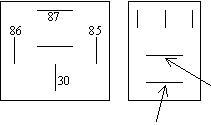The fuel pump gets its voltage from either the automatic shutdown (ASD) relay or a separate fuel pump relay tied in with the ASD relay so it turns on at the same time, (I can't remember which). The Engine Computer turns the ASD relay on for one second when you turn on the ignition switch. That is to insure fuel pressure is up and ready for starting in case it bled off while sitting for days or weeks.
Next, the computer turns the ASD relay on again during engine rotation, (cranking or running). It knows that because it receives pulses from the crankshaft position sensor and the camshaft position sensor. Those signals synchronize spark plug and fuel injector firing times too.
The easiest way to tell if the ASD circuit is working is to grab a test light or digital voltmeter and measure the voltage on the dark green / orange wire at the coil pack connector, any injector, or either small terminal on the back of the alternator. Set it up so you can see it from inside the car, or have a helper turn the ignition switch for you. If you don't see voltage on that wire for the first second, the relay has a bad contact inside or the fuse feeding it is blown. Some digital voltmeters respond too slowly to pick that voltage up. That's one place where a test light might give better results. If you don't see voltage on that circuit for the first second, you likely won't see it either while cranking the engine, however, if you DO see voltage there, that proves the relay is good and the computer has control of it.
If you don't have voltage for the first second and during cranking, troubleshoot the relay circuit. If you do have voltage, you should be hearing the fuel pump too. The next thing would be to check for voltage the same way right at the connector on the tank.
If you have voltage for the first second but not while cranking, you won't have spark or injectors firing either because both circuits get their voltage from the ASD relay. That's the time to suspect the cam or crank sensors. Also, if the timing belt has jumped two or more teeth, those two sensors will be out of synchronization and the computer will turn off the ASD relay to protect the engine from valve damage. At three teeth off, any open valves will be hit by the pistons. At just one tooth off, the computer will set a diagnostic fault code in memory and will turn on the Check Engine light but the engine will still run poorly.
Saturday, April 9th, 2011 AT 7:53 PM



